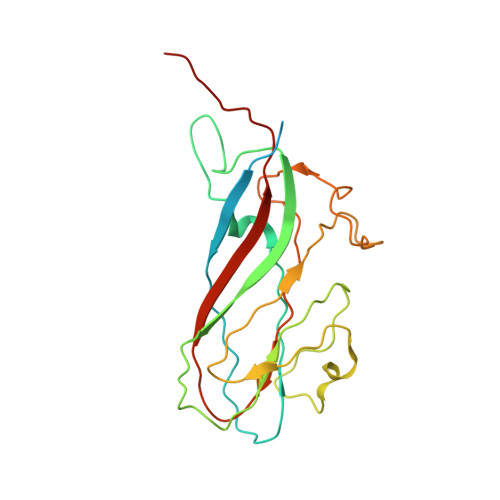Neutralization Mechanism of a Monoclonal Antibody Targeting a Porcine Circovirus Type 2 Cap Protein Conformational Epitope.
Huang, L., Sun, Z., Xia, D., Wei, Y., Sun, E., Liu, C., Zhu, H., Bian, H., Wu, H., Feng, L., Wang, J., Liu, C.(2020) J Virol 94
- PubMed: 32075932
- DOI: https://doi.org/10.1128/JVI.01836-19
- Primary Citation of Related Structures:
6L62, 6LM3 - PubMed Abstract:
Porcine circovirus type 2 (PCV2) is an important pathogen in swine herds, and its infection of pigs has caused severe economic losses to the pig industry worldwide. The capsid protein of PCV2 is the only structural protein that is associated with PCV2 infection and immunity. Here, we report a neutralizing monoclonal antibody (MAb), MAb 3A5, that binds to intact PCV2 virions of the PCV2a, PCV2b, and PCV2d genotypes. MAb 3A5 neutralized PCV2 by blocking viral attachment to PK15 cells. To further explore the neutralization mechanism, we resolved the structure of the PCV2 virion in complex with MAb 3A5 Fab fragments by using cryo-electron microscopy single-particle analysis. The binding sites were located at the topmost edges around 5-fold icosahedral symmetry axes, with each footprint covering amino acids from two adjacent capsid proteins. Most of the epitope residues (15/18 residues) were conserved among 2,273 PCV2 strains. Mutations of some amino acids within the epitope had significant effects on the neutralizing activity of MAb 3A5. This study reveals the molecular and structural bases of this PCV2-neutralizing antibody and provides new and important information for vaccine design and therapeutic antibody development against PCV2 infections. IMPORTANCE PCV2 is associated with several clinical manifestations collectively known as PCV2-associated diseases (PCVADs). Neutralizing antibodies play a crucial role in the prevention of PCVADs. We demonstrated previously that a MAb, MAb 3A5, neutralizes the PCV2a, PCV2b, and PCV2d genotypes with different degrees of efficiency, but the underlying mechanism remains elusive. Here, we report the neutralization mechanism of this MAb and the structure of the PCV2 virion in complex with MAb 3A5 Fabs, showing a binding mode in which one Fab interacted with more than two loops from two adjacent capsid proteins. This binding mode has not been observed previously for PCV2-neutralizing antibodies. Our work provides new and important information for vaccine design and therapeutic antibody development against PCV2 infections.
Organizational Affiliation:
State Key Laboratory of Veterinary Biotechnology, Harbin Veterinary Research Institute, Chinese Academy of Agricultural Sciences, Harbin, China.














